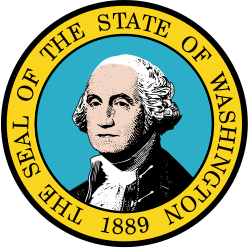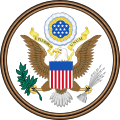Seal of the lieutenant governor
There is also a seal of the lieutenant governor of Washington, created in 1959. The seal was created to mirror aspects of regional interest that embody the traditions and culture of Washington state. The seal is represented by the official state symbols of the willow goldfinch, chosen in 1951 by a run-off between the meadowlark and the goldfinch; the coast rhododendron, voted in by Washington women prior to universal suffrage in 1892; and the twin gavels of the state legislature, representing the bipartisan spirit of lawmaking, all enclosed in a circle. At the center is the state capitol building in Olympia, one of the tallest masonry domes in the world. Two western hemlocks, the state tree since 1947, flank the seal's outer edges.
This page is based on this
Wikipedia article Text is available under the
CC BY-SA 4.0 license; additional terms may apply.
Images, videos and audio are available under their respective licenses.






